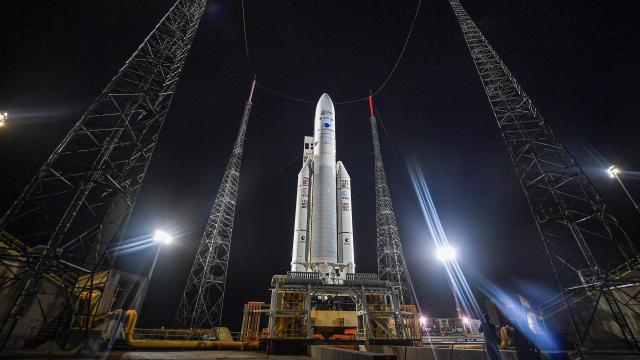After decades of waiting, the Webb Space Telescope is finally ready to blast off. You can watch this historic launch live right here.
For years now I’ve had to refer to the “upcoming” James Webb Space Telescope and make promises about how this $US10 ($14) billion observatory, a joint project of NASA, ESA, and the Canadian Space Agency (CSA), will some day fundamentally alter our view of the cosmos. For me, the experience of writing this “how to watch” post is nothing short of surreal, and I can scarcely believe it’s happening. But it’s true — the waiting appears to finally be over, as Webb is packed atop a rocket and gazing upwards into the heavens.
The space telescope is scheduled to launch at 7:20 a.m. EST (4:20 a.m. PST) on Christmas morning from the Guiana Space Centre in Kourou, French Guiana. An Ariane 5 rocket will perform the heavy lifting, blasting off from launch complex ELA-3. The 32-minute launch window for the day will end at 7:52 a.m. EST (4:52 a.m. PST).
NASA TV will provide a rocket fuelling update at 3:00 a.m. EST (12:00 a.m. PST), but the real show begins at 6:00 a.m. EST (3:00 a.m. PST). Live feeds of the launch will be made available at NASA TV, YouTube, and on ESA WEB TV ONE. Or you can stay right here and catch the action at the feed provided below.
ESA will also be broadcasting in French and Spanish. A steady stream of updates will appear on Facebook, Twitter, and Twitch, so as long as you have an internet connection you should be fine. NASA’s post-launch press conference is scheduled to start at 9:00 a.m. EST (6:00 a.m. PST), also on NASA TV.
The launch will be exciting — and completely nerve wracking — but so too will be the first hour of the mission. Webb will need to deploy its solar panels and perform a course correction manoeuvre, as the spacecraft begins its one-month journey to the second Lagrange point (a gravitationally stable spot some 1 million miles from Earth). The next steps will involve a complex series of deployments and calibrations, with Webb expected to enter into the science phase of its mission in around six months.
Webb is the largest and most powerful space telescope ever built. The infrared observatory was supposed to launch in 2007, but technical and budgetary hurdles, among other issues, resulted in the delay. Astronomers will use the telescope to observe the universe’s earliest galaxies, investigate the birthplaces of stars and planets, and scan the atmospheres of distant worlds. The mission is supposed to last for at least five years, but the goal is to keep Webb going for 10 years.
More: Here’s what could still go wrong with the Webb Space Telescope.
